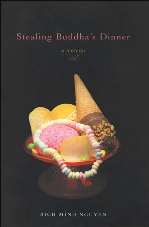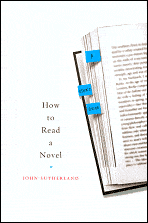A purchase, a brief review, and plan #14
March 27, 2007
Like the majority of those that are likely to be reading this, I continually struggle with a growing pile of books, purchased and borrowed, waiting to be read. I know there have even been times when I have left a bookstore with a book that wasn’t something I was looking for, but I couldn’t leave without buying something. Arg. I have to find a way to stop.
My latest purchase is a book I look forward to reading. It is not likely to become a bestseller, but it looks interesting. I stumbled on this memoir as I was browsing for something a little lighter to read.

Stealing Buddha’s Dinner is a memoir written by Bich Minh Nguyen. At an early age Bich left Vietnam in 1975 with her family and migrated to the U.S. I’ve just started the book, but I am confident that I am going to enjoy it.
I wrote that I stumbled on the book, but I actually was drawn to it. Which leads me to a few comments about another book that I recently completed, How to Read a Novel by John Sutherland. I picked up Sutherland’s book and was pleasantly surprised by the content- it is very different than most other “how to read” books. Sutherland, the chairman of the 2005 Man Booker Prize committee, writes about the entire reading experience, beginning with the reader’s process of selection.
Everything about the reader’s book selection process is discussed, and for those of us with little experience or knowledge of the book world, Sutherland provides interesting insights into the book industry. I was surprised to learn that as much as a quarter of the production costs on a hardback novel can be sunk into the dust cover. Thinking back to my purchase of the Bich memoir, that was what obviously first caught my attention- a picture of many of my favorite treats from my “coming of age” years, led me to check out the title, “Sharing Buddha’s Dinner” – (what could that possibly refer to?)
“Titles” is the title of another chapter in the Sutherland book. Again a surprise. “There is, oddly, no copyright in titles…. such duplication is infrequent – librarians, booksellers, authors, and readers themselves dislike it too much. It creates confusion.” Knowing about the lack of title copyrights cleared up a bit of confusion since I believe I have run across duplicates on occasion, and I always assumed I was mistaken.
Sutherland goes on to discuss things as mundane as the impact of the typeface, to the branding value of a well-known author’s name and the value of the blurbs written by other authors that appear on the back of the book. Hardback or Paperback. Famous first lines. The value of reviews. Illustrations. Bestsellers. Prize winners. Sutherland has an opinion on all and expresses it with humor without getting tedious. This is an very different and interesting discussion of reading and books, and it is thoroughly enjoyable.

Now, back to what really sold me on the Bich memoir. I picked it up and the read the overleaf. It turns out that the author, after leaving Saigon in 1975, landed in Grand Rapids, Michigan- about 25 miles from me. That brought it close to home. (along with the very vivid memory of watching the news and seeing that last helicopter leaving the roof of the US embassy in Saigon with a few people grasping the landing gear, trying to hold on.) The chapter titles are awesome- A memoir of an immigrant who describes her experiences of starting life in a new world shouldn’t have chapter titles like “Pringles,” “Toll House Cookies,” “Moon Cakes,” and “Dairy Cones.” Turn the page and there is a photo of 2 very cute young girls, standing on a sidewalk in front of a couple of feet of snow, wearing what looks to be pajama bottoms, winter coats, and fuzzy slippers. A reading of the first sentence made it a no brainer for me-
“We arrived in Grand Rapids with five dollars and a knapsack of clothes.” How could I put it back on the shelf? I already care about them.
Back to my personal problem. I need to alter the trend and stop the book accumulation. I keep making promises to myself- things like reading 3 books for every one that I purchase, or reading one book off the shelf before I can by another. I even had a New Year’s resolution one year not to buy a single book for a year. That lasted about a month. Plan #14 is to provide some accountability. I’m simply going to read more than I borrow or buy. But I’m going to actually track that progress here, in the sidebar, for all the world to see. Just a simple count of books purchased, books borrowed, and books read. Maybe if I keep it in front of me, I can succeed. I’ll start in April- that gives me a few days to pick up a hold at the library and make sure there isn’t a “must-have” on the new release shelf at Barnes & Noble.
March 28, 2007 at 6:50 am
That Sutherland book does sound interesting — I feel like I should know more about things like book production and costs. And I sympathize with your struggle to buy fewer books — it’s so hard!
March 29, 2007 at 7:56 am
I usually stay clear of How to Read type books because they tend to annoy me, but this one sounds really good. And I am sorry , but I had to laugh at Plan #14. Not at the plan itself, it is admirable and an attempt to solve a “problem” that I myself have as well. What made me laugh is that you aren’t starting until April so you still have time to pick up a few last books. I would do the same thing. Good luck with the Plan!
March 29, 2007 at 9:06 pm
Dorothy – There is a lot of anecdotal information in the book about the industry. The author has a good sense of humor as well.
Stefanie – It is different than the majority of books about reading that I have read in the past. I recently finish “How to Read Literature Like a Professor,” which wsa much more traditional. I have to admit learning a few things from that one as well.
It sounds like publicly exposing my failure to limit book purchases is not going to get me much chastisement from the reading community. 🙂